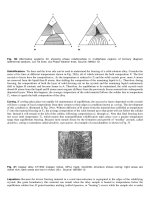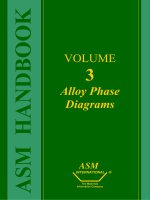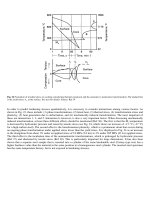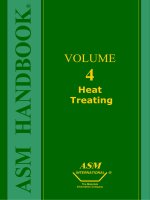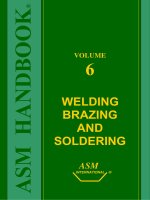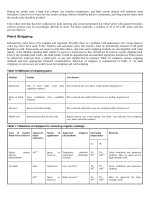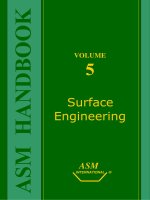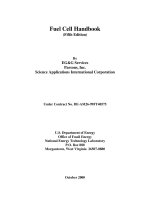Tài liệu ASM Metals HandBook P15 docx
Bạn đang xem bản rút gọn của tài liệu. Xem và tải ngay bản đầy đủ của tài liệu tại đây (662.25 KB, 40 trang )
ASM
INTERNATIONAL ®
Publication Information and Contributors
Introduction
Mechanical Testing and Evaluation was published in 2000 as Volume 8 of the ASM Handbook. The Volume
was prepared under the direction of the ASM Handbook Committee.
Volume Coordinator
The Volume Coordinators were Howard Kuhn, Concurrent Technologies Corporation and Dana Medlin, The
Timkin Company.
Authors and Contributors
• LAMET
UFRGS
• John A. Bailey
North Carolina State University
• John Barsom
Barsom Consulting Limited
• Peter Blau
Oak Ridge National Laboratory
• Kenneth Budinski
Eastman Kodak Company
• Vispi Bulsara
Cummins Engine Company
• Leif Carlsson
Florida Atlantic University
• Norm Carroll
Applied Test Systems, Inc.
• Srinivasan Chandrasekar
Purdue University
• P. Dadras
Wright State University
• K.L. DeVries
Univerisity of Utah
• George E. Dieter
University of Maryland
• James Earthman
University of California, Irvine
• Horatio Espinosa
Northwestern University
• Henry Fairman
MQS Inspection, Inc.
• Thomas Farris
Purdue University
• Andrew R. Fee
Consultant
• William W. Gerberich
University of Minnesota
• Jeffrey Gibeling
University of California, Irvine
• Amos Gilat
The Ohio State University
• Peter P. Gillis
University of Kentucky
• William Glaeser
Battelle Memorial Institute
• Blythe Gore
Northwestern University
• George (Rusty) Gray III
Los Alamos National Laboratory
• Amitava Guha
Brush Wellman Inc.
• Gary Halford
NASA Glenn Research Center at Lewis Field
• John Harding
Oxford University
• Jeffrey Hawk
Albany Research Center
• Jennifer Hay
Applied Nano Metrics, Inc.
• Robert Hayes
Metals Technology Inc.
• K.H. Herter
University of Stuttgart
• John (Tim) M. Holt
Alpha Consultants and Engineering
• Joel House
Air Force Research Laboratory
• Roger Hurst
Institute for Advanced Materials (The Netherlands)
• Ian Hutchings
University of Cambridge
• Michael Jenkins
University of Wyoming
• Steve Johnson
Georgia Institute of Technology
• Serope Kalpakjian
Illinois Institute of Technology
• Y. Katz
University of Minnesota
• Kevin M. Kit
University of Tennessee
• Brian Klotz
The General Motors Corporation
• Howard A. Kuhn
Concurrent Technologies Corporation
• John Landes
University of Tennessee
• Bradley Lerch
NASA Glenn Research Center at Lewis Field
• Peter Liaw
University of Tennessee
• John Magee
Carpenter Technology Corporation
• Frank N. Mandigo
Olin Corporation
• Michael McGaw
McGaw Technology, Inc.
• Lothar Meyer
Technische Universität Chemnitz
• James Miller
Oak Ridge National Laboratory
• Farghalli A. Mohamed
University of California
• William C. Mohr
Edison Welding Institute
• Charles A. Moyer
The Timken Company (retired)
• Yukitaka Murakami
Kyushu University
• Sia Nemat-Nasser
University of California, San Diego
• Vitali Nesterenko
University of California, San Digeo
• Todd M. Osman
U.S. Steel
• F. Otremba
University of Stuttgart
• T. Ozkai
Olin Brass Japan, Inc.
• George M. Pharr
The University of Tennessee
• Paul Phillips
The University of Tennessee
• Martin Prager
Welding Research Council and Materials Properties Council
• Lisa Pruitt
University of California, Berkeley
• George Quinn
National Institute of Standards and Technology
• J.H. Rantala
Institute for Advanced Materials (The Netherlands)
• Suran Rao
Applied Research Laboratories
• W. Ren
Air Force Research Laboratory
• Gopal Revankar
Deere & Company
• Robert Ritchie
University of California, Berkeley
• Roxanne Robinson
American Association for Laboratory Accreditation
• E. Roos
University of Stuttgart
• Clayton Rudd
Pennsylvania State University
• Jonathan Salem
NASA Glenn Research Center at Lewis Field
• P. Sandberg
Outokupa Copper
• Ashok Saxena
Georgia Institute of Technology
• Eugene Shapiro
Olin Corporation
• Ralph S. Shoberg
R.S. Technologies Ltd.
• M.E. Stevenson
The University of Alabama
• Ghatu Subhash
Michigan Technological University
• Ed Tobolski
Wilson Instruments
• N. Tymiak
University of Minnesota
• George Vander Voort
Buehler Ltd.
• Howard R. Voorhees
Materials Technology Corporation
• Robert Walsh
Florida State University
• Robert Waterhouse
University of Nottingham
• Mark Weaver
University of Alabama
• Dale Wilson
The Johns Hopkins University
• David Woodford
Materials Performance Analysis, Inc.
• Dan Zhao
Johnson Controls,Inc.
Reviewers
• Julie Bannantine
Consultant
• Raymond Bayer
Tribology Corporation
• Peter Blau
Oak Ridge National Laboratory
• Toni Brugger
Carpenter Technology Corporation
• Prabir Chaudhury
Concurrent Technologies Corporation
• Richard Cook
National Casein of California
• Dennis Damico
Lord Corporation Chemical Products Division
• Craig Darragh
The Timken Corporation
• Mahmoud Demeri
Ford Research Laboratories
• Dez Demianczuk
LTV Steel
• George E. Dieter
University of Maryland
• James Earthman
University of California/Irvine
• Kathy Faber
Northwestern University
• Henry Fairman
MQS Inspection, Inc.
• Gerard Gary
Polytechnique Institute (France)
• Thomas Gibbons
Consultant
• William Glaeser
Battelle Memorial Institute
• Jennifer Hay
Applied Nano Metrics, Inc.
• Robert Hayes
Metals Technology, Inc.
• David Heberling
Southwestern Ohio Steel
• Kent Johnson
Engineering Systems Inc.
• Brian Klotz
The General Motors Corporation
• Howard A. Kuhn
Concurrent Technologies Corporation
• Lonnie Kuntz
Mar-Test, Inc.
• David Lambert
Air Force Research Laboratory
• John Landes
University of Tennessee
• Iain LeMay
Metallurgical Consulting Services
• John Lewandowski
Case Western Reserve University
• David Lewicki
NASA Glenn Research Center at Lewis Field
• Alan Male
University of Kentucky
• John Makinson
University of Nebraska, Lincoln
• William Mankins
Metallurgical Services, Inc.
• Frank Marsh
Consultant
• Dana Medlin
The Timken Company
• Gary Miller
Allegheny Ludlum Corporation
• Sia Nemat-Nasser
University of California, San Diego
• Robert Neugebauer
Mar-Test, Inc.
• Theodore Nicholas
Air Force Research Laboratory, Wright-Patterson Air Force Base
• William Nix
Stanford University
• Todd M. Osman
U.S. Steel
• Philip Pearson
The Torrington Company
• J. Michael Pereira
NASA Research Center at Lewis Field
• Joy Ransom
Fatigue Technology, Inc.
• Gopal Revankar
Deere & Company
• Clare Rimnac
Case Western Reserve University
• Earl Ruth
Tinius Olsen Testing Machine Company, Inc.
• Ghatu Subhash
Michigan Technological University
• Yuki Sugimura
Harvard University
• Eric Taleff
The University of Texas at Austin
• Ed Tobolski
Wilson Instruments
• George Vander Voort
Buehler Ltd.
• Kenneth S. Vecchio
University of California, San Diego
Foreword
The new edition of ASM Handbook, Volume 8, Mechanical Testing and Evaluation is a substantial update and
revision of the previous volume. This latest edition of Volume 8 contains over 50 new articles, and the scope of
coverage has been broadened to include the mechanical testing of alloys, plastics, ceramics, composites, and
common engineering components such as fasteners, gears, bearings, adhesive joints, and welds. This new scope
is also complemented by substantial updates and additions in the coverage of traditional quasi-static testing,
hardness testing, surface testing, creep deformation, high strain rate testing, fracture toughness, and fatigue
testing.
The efforts of many people are to be commended for creating this useful, comprehensive reference on
mechanical testing. The ASM Handbook Committee, the editors, the authors, the reviewers, and ASM staff
have collaborated to produce a book that meets high technical standards for the benefit of engineering
communities everywhere. To all who contributed to the completion of this task, we extend our sincere thanks.
ASH Khare
President, ASM International
Michael J. DeHaemer
Managing Director, ASM International
Preface
At least three major trends have occurred since the last edition of Volume 8 in 1984. First, concurrent
engineering is growing in importance in the industrial world, and mechanical testing plays a major role in
concurrent engineering through the measurement of properties of product design, as well as for deformation
processing. ASM Handbook, Volume 20, Materials Selection and Design (1997) reflects this focus in
concurrent engineering and the broadening spectrum of involvement of materials engineers. Second, new
methods of measurement have evolved such as strain measurement by vision systems and ultrasonic methods
for measurement of elastic properties. This area will continue to grow as miniaturized sensors and computer
vision technologies mature. Third, computer modeling capabilities, based on fundamental continuum principles
and numerical methods, have entered the mainstream of everyday engineering. The validity of these computer
models depends heavily on the availability of accurate material properties from mechanical testing.
Toward this end, this revision of ASM Handbook, Volume 8 is intended to provide up-to-date, practical
information on mechanical testing for metals, plastics, ceramics, and composites. The first section,
"Introduction to Mechanical Testing and Evaluation," covers the basics of mechanical behavior of engineering
materials and general engineering aspects of mechanical testing including coverage on the accreditation of
testing laboratories, mechanical tests in metalworking operations, and the general mecahnical tests of plastics
and ceramics. The next three sections are organized around the basic modes of loading of materials: tension,
compression bending, shear, and contact loads. The first four modes (tension, compression, bending, and shear)
are the basic simple loading types for deterimation of bulk properties of materials under quasi-statis or dynamic
conditions.
The third section, "Hardness Testing," describes the various methods for indentation tesitng, which is a
relatively inexpensive test of great importance in manufacturing quality control and materials science. This
section includes new coverage on instrumented (nano-indentation) hardness testing and the special issues of
hardness testing of ceramics. Following the section on hardness testing, the fourth section addresses the
mechanical evaulation of surfaces in terms of adhesion and wear characteristics from point loading and contact
loading. These methods, often in conjunction with hardness tests, are used to determine the response of surfaces
and coatings to mechanical loads.
The next four sections cover mechanical testing under important dynamic conditions of slow strain rates (i.e.,
creep deformation and stress relaxation), high strain rate testing, dynamic fracture, and fatigue. These four
sections cover the nuances of testing materials under the basic loading types but with the added dimension of
time as a factor. Very long-term, slow rate of loading (or unloading) in creep and stress relaxation is a key
factor in many high-temperature applications and the testing of viscoelastic materials. On the opposite end of
the spectrum, high strain rate testing characterizes material response during high-speed deformation processes
and dynamic loading of products. Fracture toughness and fatigue testing are the remaining two sections
covering engineering dynamic properties. These sections include coverage on the complex effects of
temperature and environmental degradation on crack growth under cyclic or sustained loads.
Finally, the last section focuses on mechanical testing of some common types of engineering components such
as gears, bearings, welds, adhesive joints, and mechanical fasteners. A detailed article on residual stress
measurements is included, as residual stress from manufacturing operations can be a key factor in some forms
of mechanical performance such as stress corrosion cracking and fatigue life analysis. Coverage of fiber-
reinforced composites is also included as a special product form with many special and unique testing and
evaluation requirements.
In this extensive revision, the end result is over 50 new articles and an all-new Volume 8 of the ASM Handbook
series. As before, the key purpose of this Handbook volume is to explain test set-up, common testing problems
and solutions, and data interpretations so that reasonably knowledgeable, but inexperienced, engineers can
understand the factors that influence proper implementation and interpretation. Easily obtainable and
recognizable standards and research publications are referenced within each article, but every attempt is made
to provide sufficient clarification so that inexperienced readers can understand the reasons and proper
interpretation of published industrial test standards and research publications.
In this effort, we greatly appreciate the knowledgeable guidance and support of all the section editors in
developing content requirements and author recommendations. This new content would not have been possible
without their help: Peter Blau, Oak Ridge National Laboratory; James C. Earthman, University of California,
Irvine; Brian Klotz, General Motors Corporation; Peter K. Liaw, University of Tennessee; Sia Nemat-Nasser,
University of California, San Diego; Todd M. Osman, U.S. Steel Research; Gopal Revankar, Deere &
Company; Robert Ritchie, University of California at Berkeley. Finally, we are all especially indebted to the
volunteer spirit and devotion of all the authors, who have given us their time and effort in putting their expertise
and knowledge on paper for the benefit of others. This work would not have been possible without them.
Howard Kuhn
Concurrent Technologies Corporation
Dana Medlin
The Timken Company
General Information
Officers and Trustees of ASM International (1997 - 1998)
Officers
• Ash Khare, President and Trustee, National Forge Company
• Aziz I. Asphahani, Vice President and Trustee, Carus Chemical Company
• Michael J. DeHaemer, Secretary and Managing Director, ASM International
• Peter R. Strong, Treasurer, Buehler Krautkrämer
• Hans H. Portisch, Immediate Past President, Krupp VDM Austria GmbH
Trustees
• E. Daniel Albrecht, Advanced Ceramics Research, Inc.
• W. Raymond Cribb, Brush Wellman Inc.
• Gordon H. Geiger, University of Arizona-Tucson Office & Consultant, T.P. McNulty & Associates
• Walter M. Griffith, Wright-Patterson Air Force Base
• Jennie S. Hwang, H-Technologies Group Inc.
• C. "Ravi" Ravindran, Ryerson Polytechnic University
• Thomas G. Stoebe, University of Washington
• Robert C. Tucker, Jr., Praxair Surface Technologies, Inc.
• James C. Williams, The Ohio State University
Members of the ASM Handbook Committee (1984–1985)
• Craig V. Darragh
(Chair 1999-; Member 1989-)
The Timken Company
• Bruce P. Bardes (1993-)
Materials Technology Solutions Company
• Rodney R. Boyer (1982-1985; 1995-)
Boeing Commercial Airplane Group
• Toni M. Brugger (1993-)
Carpenter Technology Corporation
• Henry E. Fairman (1993-)
MQS Inspection Inc.
• Michelle Gauthier (1990-)
Raytheon Systems Company
• Larry D. Hanke (1994-)
Materials Evaluation and Engineering Inc.
• Jeffrey A. Hawk (1997-)
U.S. Department of Energy
• Dennis D. Huffman (1982-)
The Timken Company
• S. Jim Ibarra, Jr. (1991-)
Amoco Corporation
• Dwight Janoff (1995-)
FMC Corporation
• Kent L. Johnson (1999-)
Engineering Systems, Inc.
• Paul J. Kovach (1995-)
Stress Engineering Services Inc.
• Peter W. Lee (1990-)
The Timken Company
• Donald R. Lesuer (1999-)
Lawrence Livermore National Laboratory
• Huimin Liu (1999-)
Citation Corporation
• William L. Mankins(1989-)
Metallurgical Services Inc.
• Dana J. Medlin (1998-)
The Timken Company
• Mahi Sahoo (1993-)
CANMET
• Srikanth Raghunathan (1999-)
Nanomat Inc.
• Karl P. Staudhammer (1997-)
Los Alamos National Laboratory
• Kenneth B. Tator (1991-)
KTA-Tator Inc.
• George F. Vander Voort (1997-)
Buehler Ltd.
• Dan Zhao (1996-)
Johnson Controls Inc.
Previous Chairs of the ASM Handbook Committee
• R. J. Austin
(1992–1994) (Member, 1984-)
• L.B. Case
(1931–1933) (Member, 1927–1933)
• T.D. Cooper
(1984-1986) (Member 1981-1986)
• E.O. Dixon
(1952–1954) (Member, 1947–1955)
• R.L. Dowdell
(1938–1939) (Member, 1935–1939)


